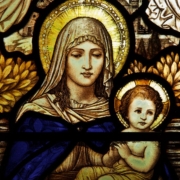Why I Wear a Chapel Veil and an Unexpected Benefit
Why I Wear a Chapel Veil and an Unexpected Benefit
At every Mass and each time I am in a place with Jesus truly present in the Eucharist, I don my chapel veil.
I’ve been wearing a mantilla for just over a year. I’m not the only one in my parish, but we are among the vast minority. Today, canon law doesn’t require women to cover their heads. Yet, though entirely optional, veiling at Mass is a beautiful way to outwardly express your reverence: at its core, wearing a chapel veil is a tangible expression of awe and humility before the Eucharist.
What initially sparked my interest was that the women who wore chapel veils in my parish were the women whom I wanted to be like. I knew some of them personally, and their entire lives bore witness to Christianity. For them, the Faith wasn’t something practiced for an hour on Sundays; their entire lives embodied it.
For months I admired their mantillas from afar, still unsure if I had the confidence to pull one off. I felt nervous about drawing attention to myself. Yet, week after week, I found myself thinking about veiling for Mass.
Thus began the Great Internet Search of 2023. I sought out every article I could find about women wearing mantillas. I read about the history, why the practice stopped, and why women do choose to veil. I learned how it serves as a physical reminder to focus our minds and hearts on the presence of Christ in the Eucharist, fostering a deeper sense of spiritual connection and intimacy with God. In a world filled with distractions, the simple act of covering one’s head can create a sacred space for prayer and contemplation.
I was especially drawn to the fact that veiling means embracing my femininity. Men have never covered their heads. (In fact, the canon law was to uncover their heads, hence the tradition of removing hats when entering a church). Some movements in the secular world espouse that women should do everything the same as men, but the Church (and I) says, “Thank You, God, that men and women are different yet equal in dignity.” I am a beautiful, feminine woman, and wearing a lace veil is overtly embracing that.
I also felt compelled to have a sacred item I only wear for Jesus. I always try to dress up for Mass, but sometimes (particularly on weekdays or during very cold weather) my attire is less than glamorous. As I pilgrimaged around Poland last month, jeans were typical during Mass. Yet every time I stepped into a church, I wore my veil to remind myself in Whose presence I was.
The clincher was that Mary is never depicted without a head covering. This struck me right to the heart. I desire to be like Mary, to follow in her footsteps of faith, helping draw others to Christ. I aim to echo her Fiat throughout my life. Choosing to veil ultimately came down to my desire to be like her.
I took the plunge and haven’t looked back. I felt a little nervous and self-conscious the first time, but that quickly dissipated. I don’t worry about what anyone else thinks because I know my reasons: I seek to please God and detach from the opinions of others. Veiling is automatic for me now. If I do happen to forget my veil, I feel underdressed, regardless of what clothes I’m wearing.
And now, I recognize a completely unexpected benefit of wearing a veil at Mass. My veil hangs onto my forehead and around my face, creating a little cove just for me. The veil blocks out distractions in my peripheral vision like horses wearing blinders in a parade. When I sit at Mass and gaze at the altar, I don’t see the movements of those around me like I used to. My vision is limited to what—Who—is in front of me. My veil reminds me of what my focus should be on, and helps me keep that focus. An unexpected gift from a simple mantilla.
If you’re discerning wearing a chapel veil, I encourage you to pray about it and listen to how the Holy Spirit is moving in your heart. There is no list of reasons for or against veiling that can compare with hearing the call from within you.
© Maria Riley 2024








